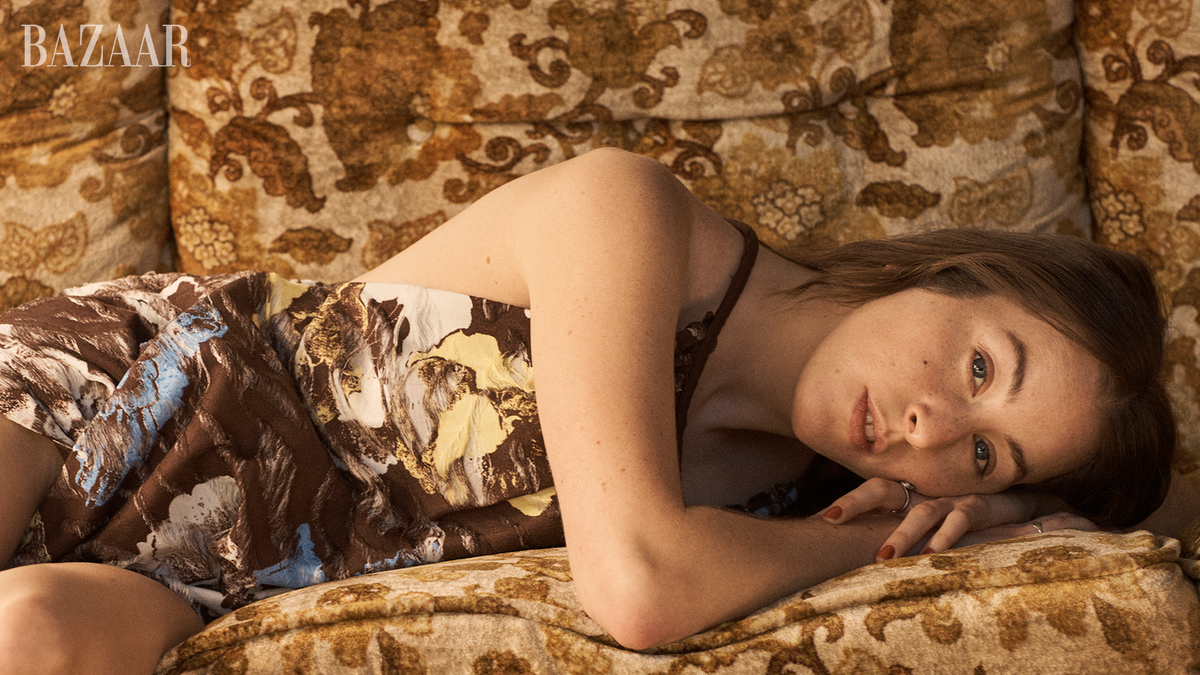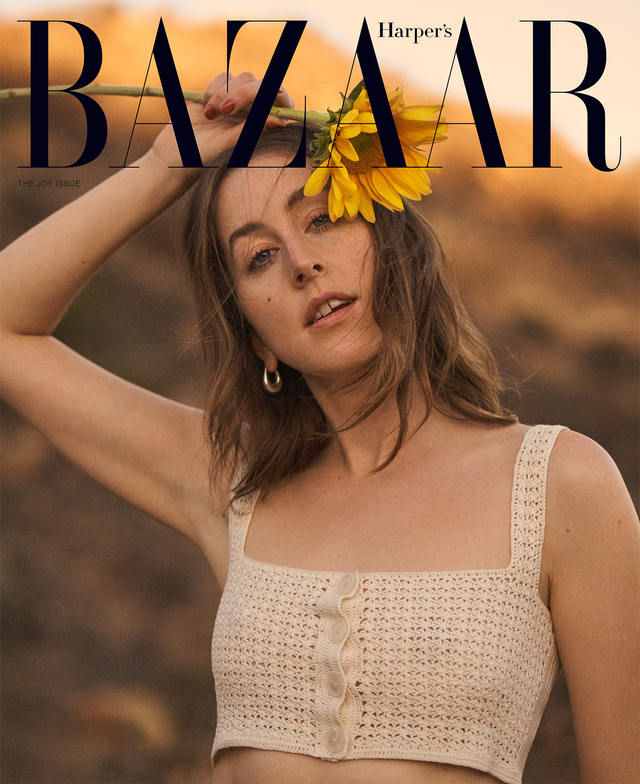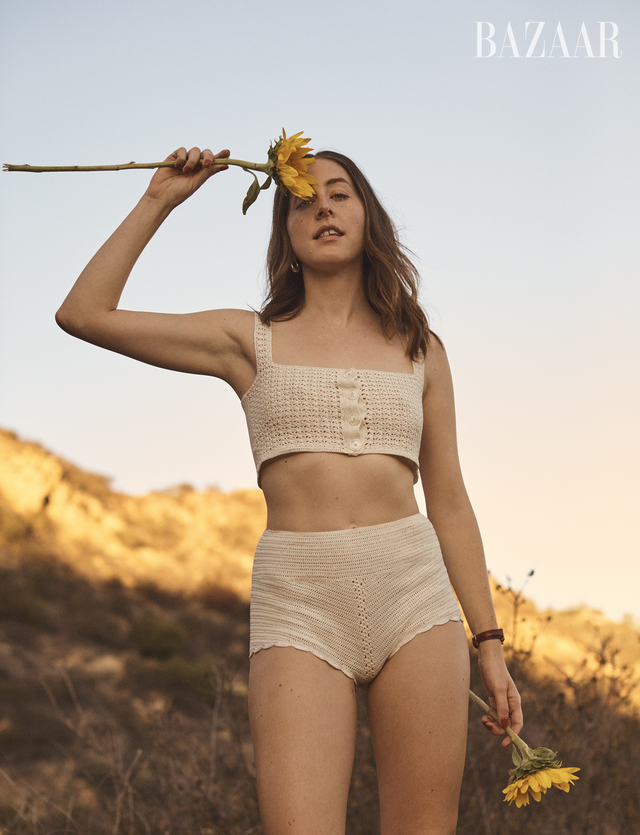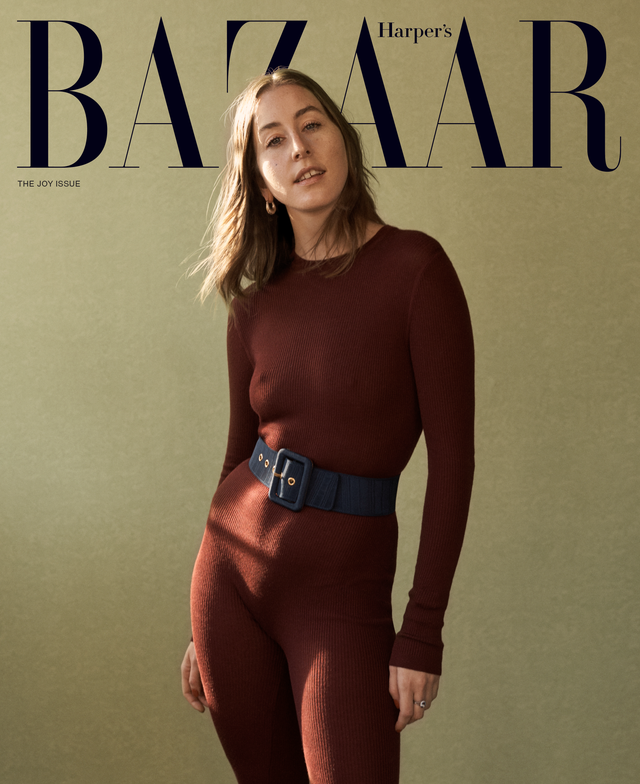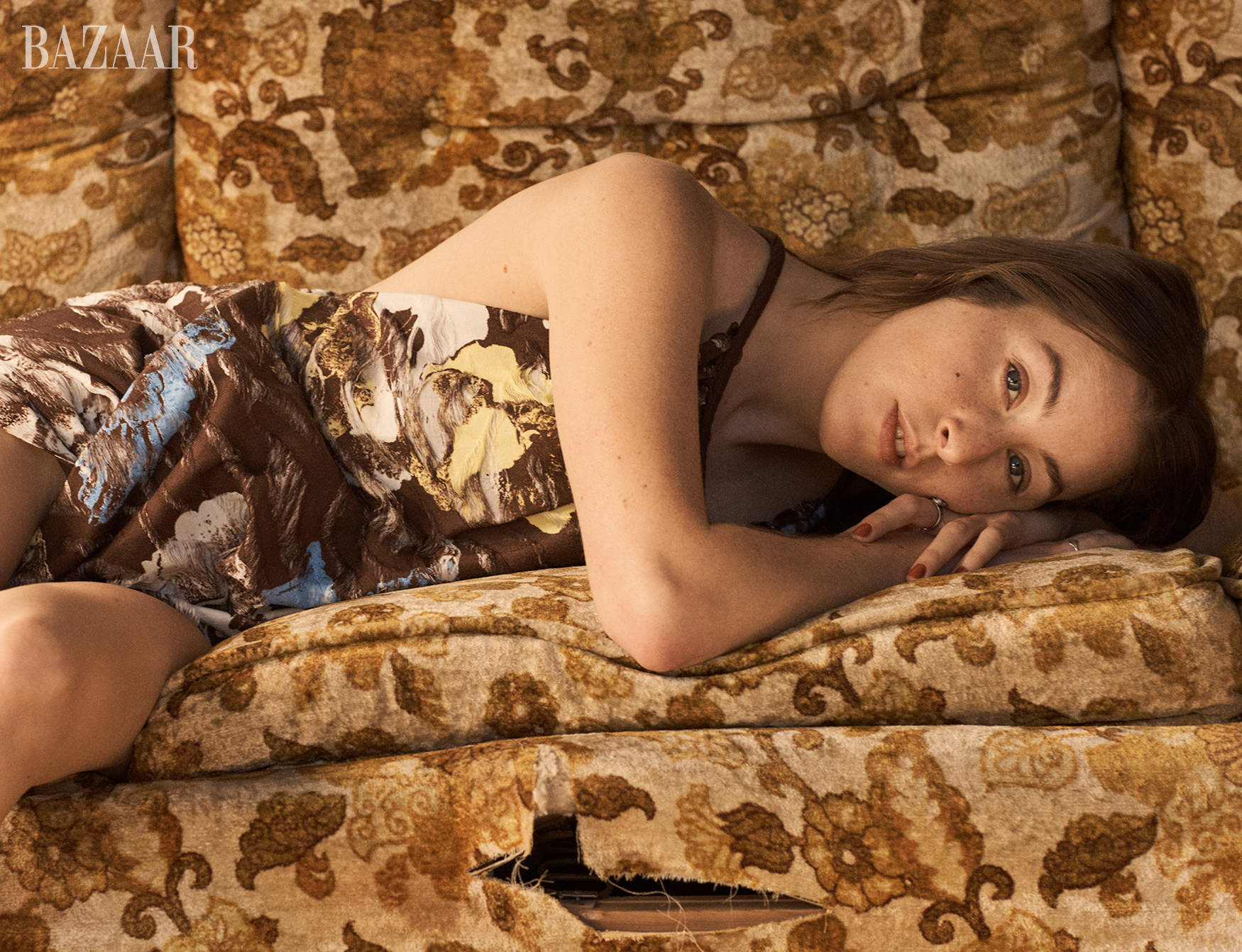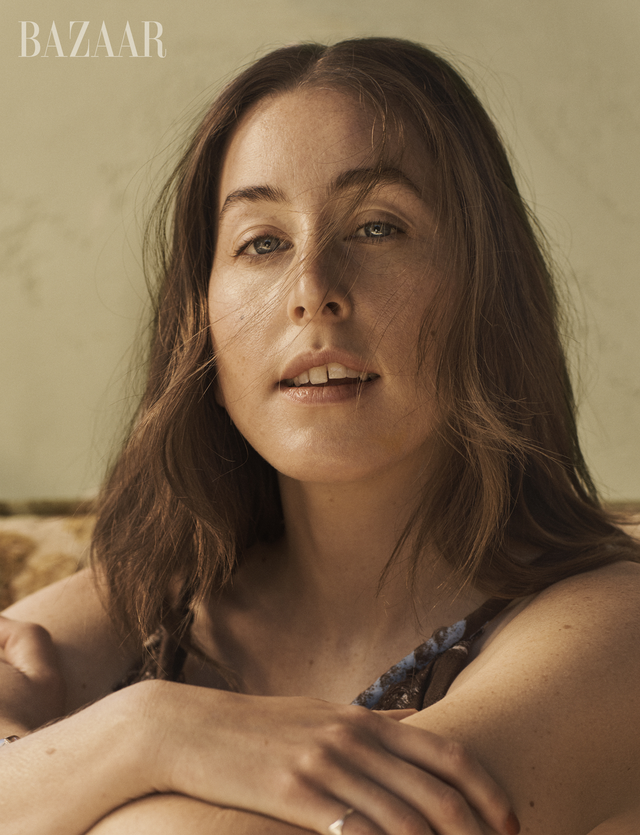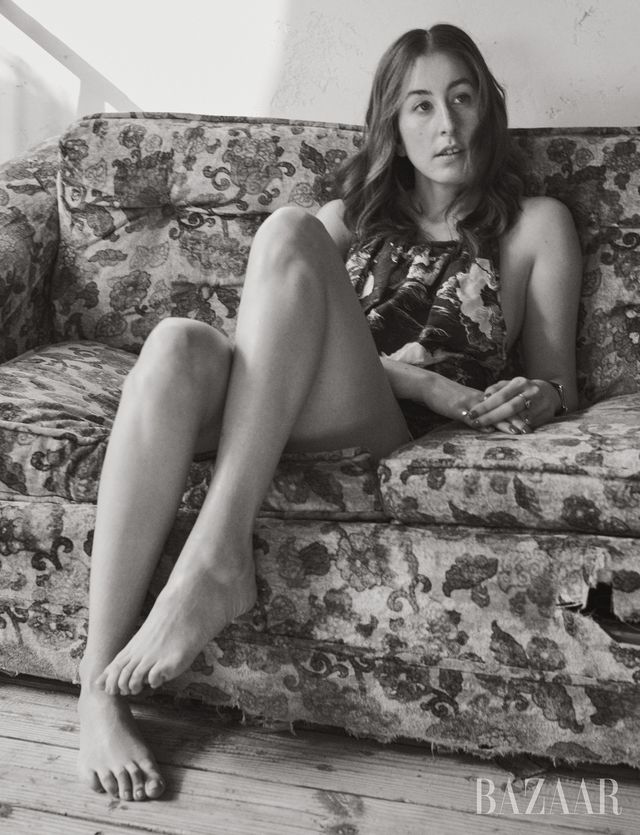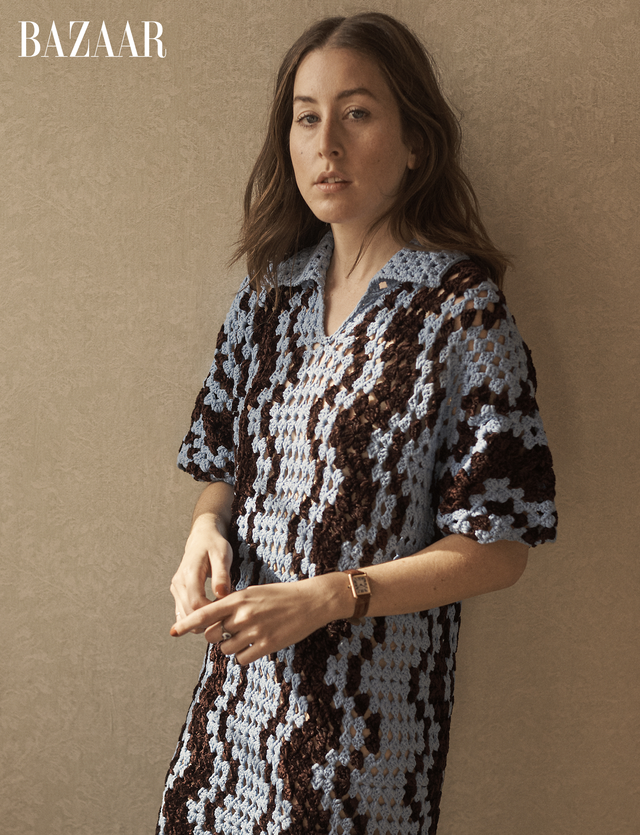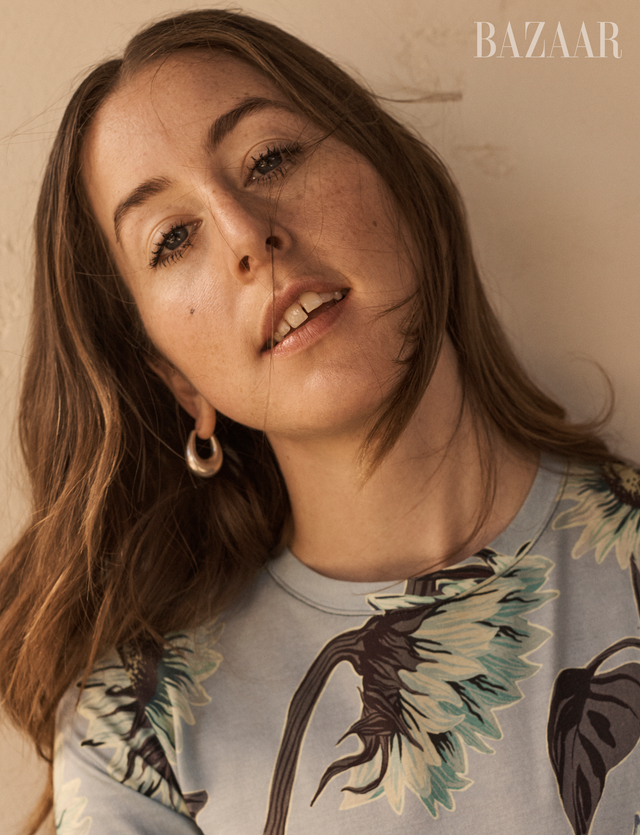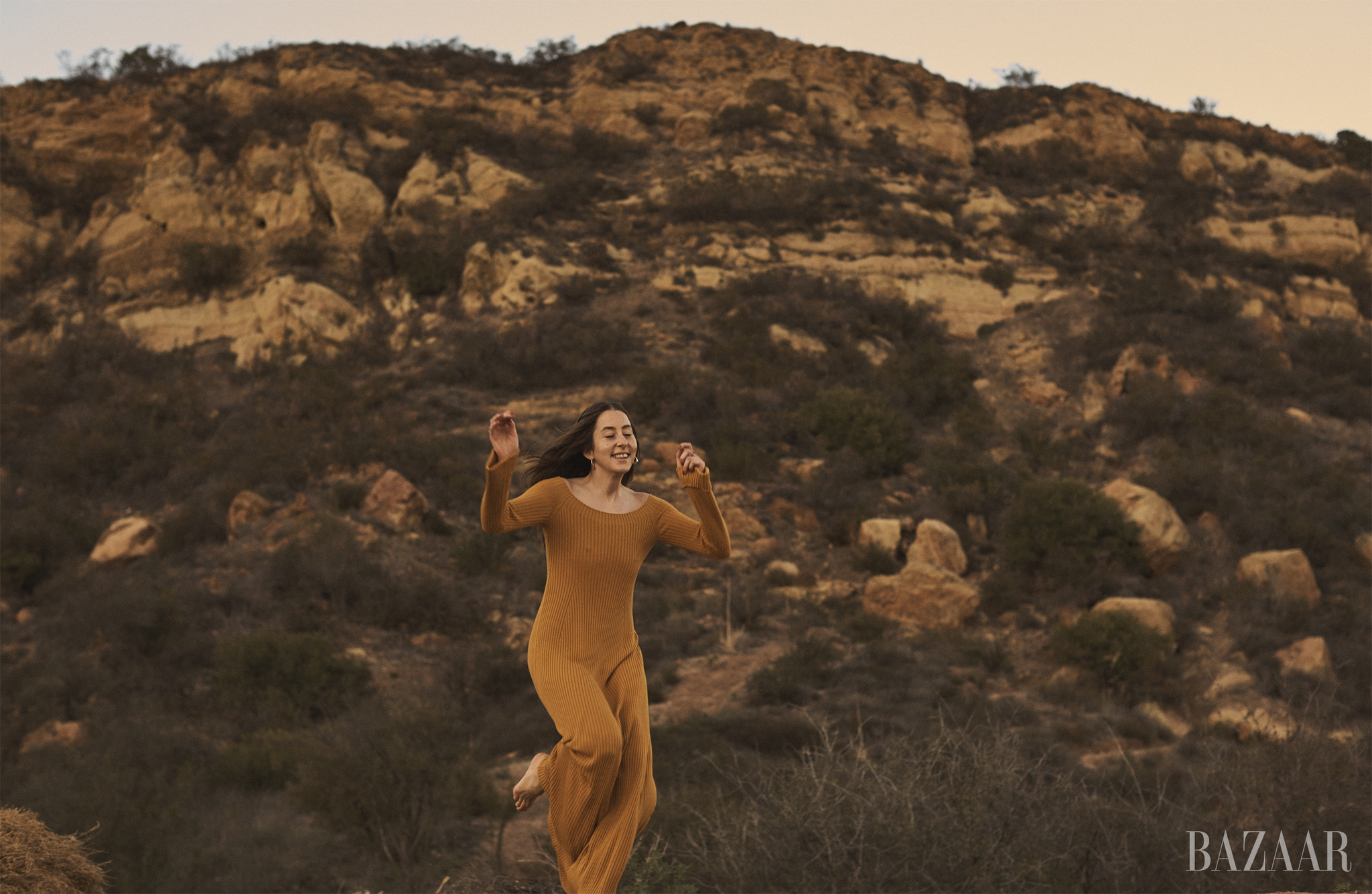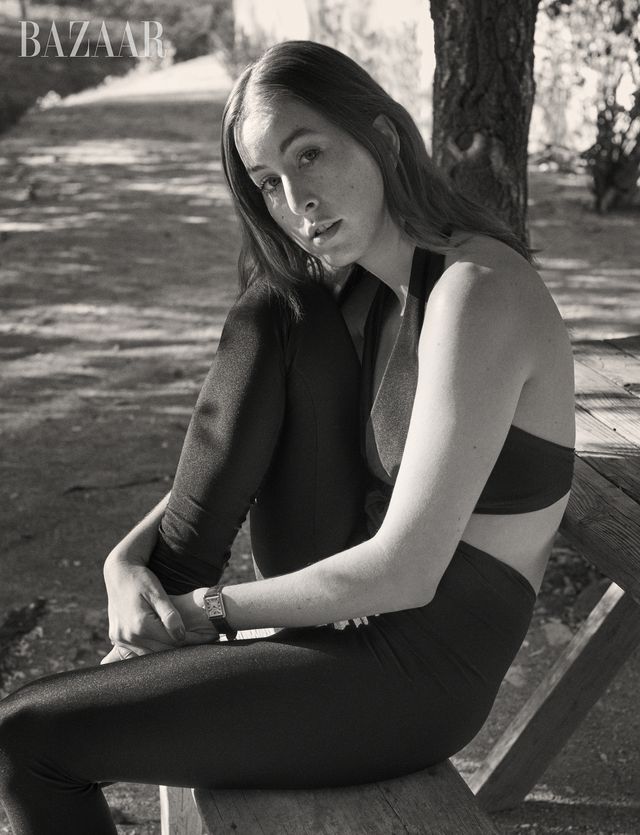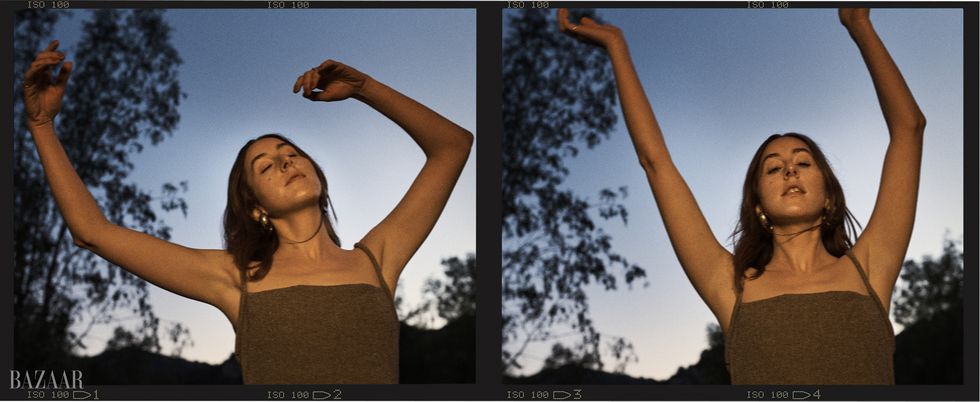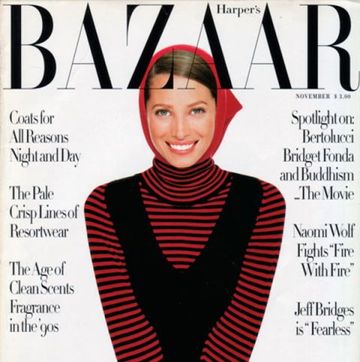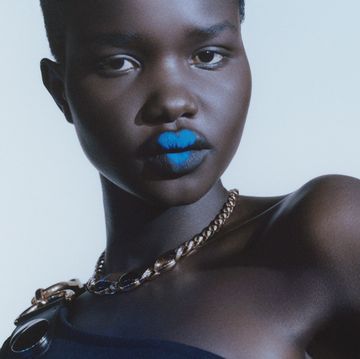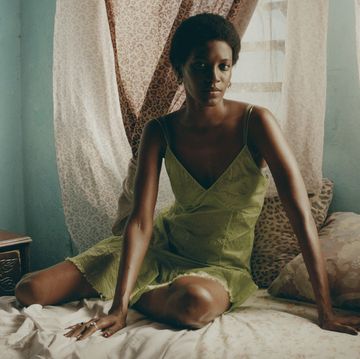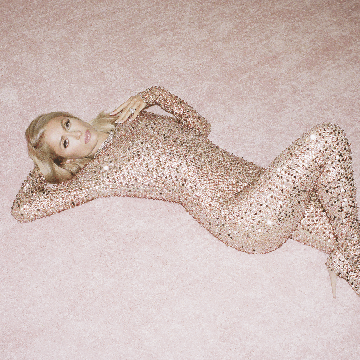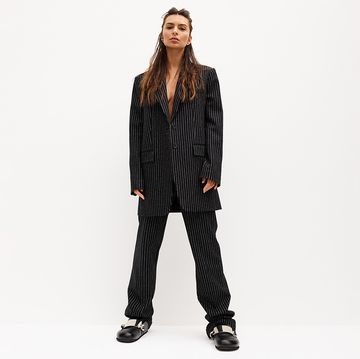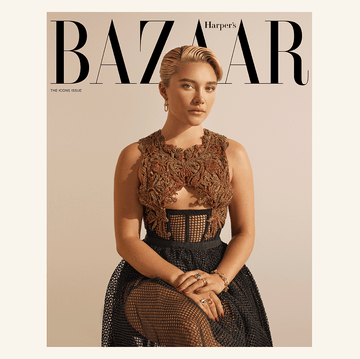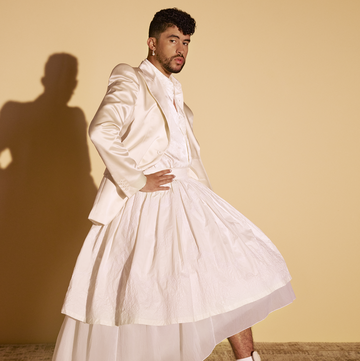It’s a hazy Monday morning in the San Fernando Valley at Art’s, the Jewish deli and restaurant in Studio City. Art’s, which has been around since 1957, is always the same: matzo ball soup and cozy brown vinyl booths. The crowd is a snapshot of the Valley at large: ancient brunch regulars, show-business folks from the nearby TV studios, and multigenerational family gatherings. The decades blend together here into a continuous now, and that’s when Alana Haim bops in through the door out of focus—a flurry of shiny brown hair in long slacks and a pink and yellow sweater vest.
Haim greets me with a hug and smiles, showing her overlapping front teeth. She’s a gamine Jewish Valley girl with a great punim, a Yiddishism (used mostly by grandmas) for someone with a cute face. She orders a lox plate with a toasted onion bagel and, after confirming it comes with tomato, onion, and capers, lets the waiter know she’ll assemble the bagel herself. “This is literally my happy place,” she says, beaming. I feel like we’ve met before, both because we grew up about a mile apart in Valley Village and because she makes such an indelible impression playing Alana Kane in Paul Thomas Anderson’s Licorice Pizza, a love story set in the Valley in 1973. It marks her first-ever acting role. (She is better known as the youngest sister in the Grammy-nominated pop-rock sister trio Haim, the one who just celebrated her 30th birthday with friend and super fan and fellow Sagittarius Taylor Swift.) Alana Kane is familiar as a young woman questing for her sense of self, trying on different sorts of adult roles and finding out she still has much to learn. She crosses paths with Gary Valentine (Cooper Hoffman), a teenage actor with a related issue: He’s overly mature but clearly just a kid imitating adults around him. Their confidence and ability to talk nonstop is a front for the fact that they have no clue what they’re doing. Neither one of them can relate to anyone else, and they pursue kicks together and apart. The movie is built around Haim’s real life and family; her sisters, Danielle and Este, and parents, Donna and Mordechai (“Moti,” an Israeli-born former soccer player), also play semifictional versions of themselves.
Paul Thomas Anderson, who also grew up in the Valley, has known Alana and the Haim family for years. Matriarch Donna taught a seven-year-old Anderson art. (When Anderson had the Haim sisters over for dinner years ago, he pulled out a painting of the mountain from Close Encounters of the Third Kind he had done in their mom’s class.) They connected in the ways you assume people who grow up around L.A. do: Anderson was a fan of the trio’s music, and a mutual friend ultimately put them in touch. (Anderson also has three daughters, as well as a son, with actor Maya Rudolph.) The introduction led to a friendship—they bonded over growing up in the Valley—which led to various collaborations over the years. Anderson has directed seven Haim music videos, and clearly something about Alana stuck out. He describes her as having a quality “like a magnet. It pulled me in and made me concoct a story that could fit her talent.”
Haim never thought about acting, even when Anderson suggested it. “I remember him looking at me and being like, ‘I’m going to put you in a movie one day,’ ” she recalls. “And I was like, ‘Okay!’ ” her voice signaling she did not think he was really going to put her in a movie. While she was in London in 2019, he sent her a Word doc containing a screenplay. It was the first script she’d ever read. “It was an untitled script,” she says, “and the first name on the script was Alana. And I was like, ‘That’s crazy, Paul’s going to use my name in a movie.’ I read the script I think three times that night. It had so much of the Valley in it and so much of the things I grew up with. A lot of stories that I had told Paul were in the script already. I was just obsessed with it.” Haim called him to tell him she loved the script, and Anderson asked if she’d have any interest in playing the role. “Immediately I said yes, because of course,” Haim recalls. “But then that night, I was like, ‘Wait, am I going to be in a fucking movie? Can I do this?’ ” She got nervous at the prospect of being terrible, but Anderson reassured her that all she had to do was be herself. He knew that Haim’s natural charisma would translate on-screen.
Haim’s character, Alana Kane, is a composite of girls Anderson knew growing up in the Valley. “There was a friend of mine who had an older sister,” he says. “The older sister had a very cool pack of girlfriends. They dressed well, they were funny, they were good-looking and sweet enough to indulge her younger brother’s friends and give us rides from time to time. A few of them, who weren’t overly cool, ended up spending a bit more time with us, and we formed lasting friendships.”
Acting, Haim says, “was so out of my depth that every day, it just felt like an adventure, in a good way.” She learned to drive stick shift for a crucial scene involving a moving truck. Cooper Hoffman, whose late father, Philip Seymour Hoffman, worked with Anderson on several movies, including Boogie Nights, which Haim calls “the quintessential Valley movie,” was also making his film debut. So Haim had good company as a neophyte actor with a director who knows what he’s doing. “Paul weirdly does make you feel invincible,” she says. “Even working with him with Haim [the band], he was really the first person to be like a true cheerleader; he always believed in us. And it’s so nice to have someone to be like, ‘You can do it.’ ’Cause there’s not a lot of people that, when you actually think about it, do that other than your parents.”
But Anderson thinks Alana is the real deal: “As the director of the film, there isn’t a scene I don’t think she’s anything short of a miracle in. She’s crazy great.” Haim is dazzling in the movie. She plays the character so naturally, it feels like she’s not even acting, which is the hardest trick to pull off. She has received raves for her performance from the most hardened of movie critics, and the award nominations have followed. It’s impossible not to be melted by the force of her charisma.
She is in a great mood today at Art’s, delighted each time the waitstaff offers a refill of coffee. “I’ve never been more happy in my whole fucking life.”
Delis are Haim’s comfort zone. She rattles off a list of other Valley delis and tells me rapturously about her mom’s matzo ball soup. Her family has Shabbat dinners, but they aren’t super observant. Haim describes them as “religious in the sense that we like to eat.” Her parents are real-estate agents who raised their daughters on a diet of rock music, and they all had a family cover band called Rockinhaim that gigged at the Kibitz Room, the club next to another famous L.A. deli, Canter’s on Fairfax. (The sisters paid homage to it with the Anderson-shot Women in Music Pt. III album cover, depicting them behind the Canter’s deli counter.) There’s a scene in Licorice Pizza when a talent agent sizes up Alana and tells her she has “a very Jewish nose,” which she notes is becoming trendy. There was a brief cultural moment when the success of movies like The Graduate, The Godfather, and The Way We Were made it fashionable to cast untraditional (meaning white ethnic) actors as leads without changing their noses or last names. Haim feels like a throwback to screwball comediennes but also the ’70s moment when Hollywood’s rigid Aryan beauty standards were busted open by women like Barbra Streisand and Pam Grier, whose very appeal was that their beauty was not interchangeable with anyone else’s. In the era of the indistinguishable “Instagram face,” Haim’s performance makes a convincing argument that to be truly funny and irrepressibly alluring, you must abandon self- consciousness and that real beauty is about self-possession.
At least that’s how her character, Alana Kane, seems to attract people. As for what it takes to date the real Alana Haim? “I’m looking for my Albert Brooks, and I’ve been saying that forever.” Her favorite movie of his is 1991’s Defending Your Life. “If you’re like Albert Brooks, I am here for you. That’s all I care about.” He also has to be good at long distance: “If he’s okay with me constantly being on the road, constantly touring. That’s the hardest thing. I mean, I’m always gone.” She was in love once, around a decade ago, and says it was an issue of “timing,” but she’s grateful for the experience. “I feel like that first love is just so deeply intense. The first cut is the deepest. All the songs are true, and you never have a love like that ever again. I think that’s a thing that’s kind of sad about it. Once you have that first love that cuts you so deeply, you never will feel that deeply ever again.” After that, she says, you build up walls.
If you are strong enough to be her man, she’s currently single and a Sagittarius sun, Aries moon, and Libra rising. “I’m very L.A. in that sense, where I’m very into star science and horoscopes and all that jazz.” For now, she’s prioritizing the touring rock-star life: “The road is my husband, my boyfriend, my everything.” Her band has a different vibe of arena rock than the sisters’ ’70s heroes (Fleetwood Mac, the Eagles), though they shred as hard. “People ask us what’s the most rock-star thing we’ve done. Maybe they watch too many ’80s documentaries about bands from the ’80s. They’re like, ‘Do you throw TVs out the window?’ And I’m like, ‘No. I don’t even know why anyone did that in the first place.’ ” She adds that playing shows is physically exhausting and they sweat nonstop. “I am so jealous of people that can go out. Maybe it’s because I’m Jewish. I’m, like, too scared to get sick. So I never go out after shows. We’ve never been those kinds of girls. We’re like, ‘No, we have our fun onstage. That’s all we need.’ ” Her dad is calling. She’s going to his house after breakfast to help her parents fix their computer printer.
Having devoured the lox plates, we move on to reflect on the ways the Valley is changing. The Du-par’s down the street, a late-night diner that appeared in Boogie Nights, is now a Sephora. The Sportsmen’s Lodge, a midcentury hotel where every Jewish kid in L.A. attended countless bar and bat mitzvahs, is slated to be demolished; the high-end health-food store Erewhon opened across the street at an adjacent mall.
Within L.A., the Valley was often derided by those on the other side of the hills, fostering a defensiveness that engenders underdog pride. “Exactly,” says Haim. “Because everyone hated on us. So that banded us together.” She describes the Valley as “its own bubble,” where temperatures are a little higher and life is mostly in the slow lane. “The biggest question mark of the summer was, who has a pool?” she says, acting out frantically asking everyone in sight if they know someone who has a pool.
The Valley doubles for many places on-screen, mostly generic suburbia but also Morocco in Casablanca (shot at a Burbank studio and an airport in Van Nuys) and the moors of England in William Wyler’s Wuthering Heights (shot in Thousand Oaks). Anderson’s movies portray the Valley with specificity and affection; the shambling suburban fuzziness is beautiful. Like the rest of L.A., the Valley is extreme: Rich enclaves bump right up against poor neighborhoods. In the ’80s, the idea of the “Valley girl” was popularized, depicting a vapid airhead obsessed with clothes and money. It was also a little bit anti-Semitic, overlapping with the stereotype of the Jewish American princess. The stereotype of the dumb Valley girl is just, like … made up? Marilyn Monroe was at one point a Valley girl (Van Nuys High), and so was Susan Sontag (North Hollywood High).
It is the place where the less glamorous but deeply important side of the entertainment world lives, including session musicians and people who work what’s called “below the line.”
“I think it’s pretty clear that my sisters and I have a deep affinity for everything that goes on in the 818,” says Este Haim, referring to the Valley’s area code. She tells me how Pat Benatar’s session guitarist was their neighbor, before launching into a vocal approximation of the guitar from “Hit Me With Your Best Shot.” Living around people who made a living in the business as full-time working musicians inspired the Haims.
Like many 818-ers, Haim grew up adjacent to the entertainment world but without connections. Rockinhaim was not a vehicle to make them child stars, she says, just a thing they did for fun. Her parents were far too protective to let them be Disney kids, but other kids’ parents weren’t. She remembers a class project for which kids had to bring in a photo of themselves. “Every single person in my class had a headshot except for me.” She smiles at the absurdity. “Everyone wanted to be actors and in the business so young. I was not about that situation.” She never had an expectation that she’d end up in a movie someday.
“My whole childhood was my dad not letting me walk anywhere or do anything. I had no freedom,” she says. It wasn’t until Este, the eldest sister, got her license that the Haim girls could even escape from the Valley at all. They went to the beach once a year, to the Santa Monica Pier or the Venice Beach Boardwalk on Christmas.
“When Este got her license,” Haim tells me, “it was like the world: We finally had a passport to Los Angeles. Because other than going to Canter’s or the once-in-a-blue-moon trip to see the ocean, which took forever because you’re in crazy traffic—my parents were always working, so if they weren’t home, we couldn’t go anywhere. We didn’t have Uber, and we were never going to take a cab.” The girls didn’t rebel or sneak out because they were good kids who knew they’d get caught instantly. “My dad has eagle-eye hearing. None of us ever successfully snuck out of my house ever.” She kept living at home in her early 20s and even then had a midnight curfew that involved rushing home to make sure a light was shut off. Driver’s licenses allowed the girls to bond outside the house. Danielle became Alana’s carpool driver, and when they were a senior and freshman, she would convince her to skip school together. Having cool older sisters meant Alana got a fake ID when she was 16; they told her not to smile for the photo so her braces wouldn’t show. “It was the worst fake ID I’ve ever seen in my life,” Haim says now. For Danielle’s 16th birthday dinner at the Universal City Buca di Beppo, Alana remembers how Este “bought a stack of CDs for Danielle, and one of the CDs was the Boogie Nights soundtrack. And that was like our first introduction. I knew Paul through his soundtracks before I knew him through his movies.” She didn’t see the uncensored movie until much later.
“I know it feels like it’s getting kind of cool to be from the Valley,” Haim says. “It just is like a very new concept for me.” She hasn’t decided what’s next for her, if anything, acting-wise. Endearingly, she tells me that she has “no idea how this thing works,” referring to all the machinations that go into promoting a film. (“I just wait every day for someone to call me and be like, ‘Be here at this time.’ And I’m like, ‘Okay.’ ”) For now, she’s focused on Haim’s upcoming tour, in which they are headlining the Hollywood Bowl for the first time. The awesomeness of this trajectory isn’t lost on her, that the girl who once dreamed about just leaving the house after dark will get to play the most iconic venue in Los Angeles with her sisters in their band the same year she generated Oscar buzz in her first movie. Valley girls may be underdogs, but that’s exactly why you should never count them out.
Hair: Tomo Jidai for Oribe; Makeup: Kiki Gifford for Chanel Les Beiges; Manicure: Stephanie Stone for Essie; Production: Moxie Productions; Prop Styling: Tim Gehling.
Video: Director of Photography & Editor: Tyler Kohlhoff; 1st AC: Adriel Gonzales; Premiere Gymnopedie performed by Stelios Phili
